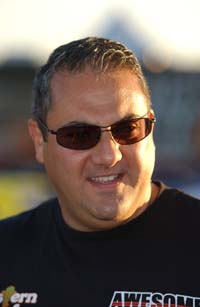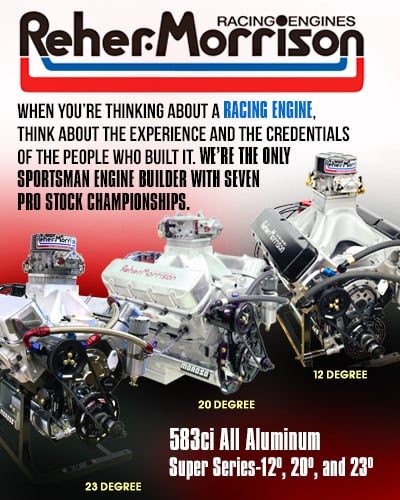CASTELLANA’S SPEED SECRETS
Mon, 2008-08-04 21:35
 Mike Castellana isn’t really sure what to believe regarding his
recent performance at the IHRA Torco Northern Nationals in Martin, Michigan. The veteran nitrous Pro Modified
racer knows he’s running quicker than ever, but he’s also aware his
supercharged adversaries aren’t running as quick as they could.
Mike Castellana isn’t really sure what to believe regarding his
recent performance at the IHRA Torco Northern Nationals in Martin, Michigan. The veteran nitrous Pro Modified
racer knows he’s running quicker than ever, but he’s also aware his
supercharged adversaries aren’t running as quick as they could. Regardless of the answer, the 2006 IHRA Pro Modified world champion is doing everything he can to gain a performance advantage while the hot summer months favor his combination.
Castellana knows that he’s got to make hay while the sun is out.
“Hopefully if we can outrun them [supercharged racers] during the hot months of summer, when the weather cools down maybe we can just keep pace with them,” Castellana explained. “We have made some gains no doubt, but the racing should be a lot closer than it has been this weekend.” Nitrous front-runner on the edge of the five-second zone …
 Mike Castellana isn’t really sure what to believe regarding his
recent performance at the IHRA Torco Northern Nationals in Martin, Michigan. The veteran nitrous Pro Modified
racer knows he’s running quicker than ever, but he’s also aware his
supercharged adversaries aren’t running as quick as they could.
Mike Castellana isn’t really sure what to believe regarding his
recent performance at the IHRA Torco Northern Nationals in Martin, Michigan. The veteran nitrous Pro Modified
racer knows he’s running quicker than ever, but he’s also aware his
supercharged adversaries aren’t running as quick as they could. Castellana’s bid to climb to the top of the nitrous ladder began in late 2006 when he and crew chief Shannon Jenkins underneath the cloak of darkness walked away from their longtime relationship with engine builder Gene Fulton in order to travel a different path with David Reher and Reher & Morrison race engines.
The end result of the transition has been a steady increase of performance gains for the nitrous combination. A 6.000 by Castellana during the first round of eliminations is the closest any nitrous racer has come to the elusive five second zone.
“We’ve been working hard with Reher-Morrison Racing Engines and (they've) provided us with lots of power to start with,” Castellana explained. “Speedtech nitrous, we’ve been working on some good things and it’s been paying off. Shannon tunes them and Brandon working on the nitrous stuff; and now we’ve got Rickie Smith thrown in there. It’s just a win-win situation.”
Castellana’s program received a major boost when his Awesome Motorsports pooled resources with the Middle Eastern-based Al-Anabi Motorsports to create a Pro Modified powerhouse. For the first time since Jenkins walked away from driving on the IHRA front, Castellana has a teammate.
Rickie Smith made his debut this weekend adding even more data to computer to draw from.
Castellana is inspecting every inch of their combination for improvement potential. That’s a tough task for the Awesome/Al-Anabi operation considering Reher’s formula for extracting performance from nitrous motors.
Instead of adding mega cubic inches and throwing tons of nitrous into the mix, Reher has created horsepower within the powerplant and gradually added nitrous to the combination.
Reher is well practiced at the art of extracting horsepower from naturally aspirated engines of the larger nature. From 1983 through 1985, the Reher-Morrison team dominated the IHRA’s mountain motor Pro Stock division.
“You have to keep the motor nitrous friendly,” Castellana explained. “You can’t just take nitrous and put it on the Mountain Motor Pro Stock engine and think it’s going to run better. You have to find that right combination.”

Mike Castellana exerted nitrous dominance in Martin, Michigan, over the course of the weekend. He posted the quickest-ever nitrous run with a 6.000.
“The object is getting the engine to handle more nitrous,” added Castellana. “We’ve run just as fast with less nitrous but what we’re doing is adding more nitrous to it and get the motors able to handle more.”
He pointed out there have been significant cylinder head improvements as well. Another has been understanding at what point on the track the car accelerates the best.
Traditionally the nitrous combination has made it’s best incremental times early in the run, only to be overshadowed by the torque-oriented supercharged cars in the last half of the strip. Castellana said his car has been just the opposite.
“The last couple of races I’ve had comments from some of the blower guys saying they’ve never had a nitrous car pull away from them on the back end of the race track and that’s what we’ve been able to do,” Castellana said. “I don’t think there’s any difference, right now, in the back end.”
“The way run these motors, they run great on the back end of the track. We were kind of lacking a little bit on the front half; our short times were not as good as some of the other cars. That’s what we’re working on now. We seem to have gotten that, a good front half and back half.”
What pleases Castellana even more is the reasonable parts bill. He’s on the cusp of the five second zone and this performance has not been at the expense of destroying parts.
“They’re close to the edge,” Castellana admitted. “They aren’t over the edge right now. We’re picking up a little at a time, not trying to kill them. We’ve been very fortunate. We haven’t hurt an engine since we signed the deal with Reher-Morrison. [We] haven’t burnt a piston or anything. I shouldn’t be saying that now because we’ll go out there now and burn one up.”
Sure enough, Castellana did just that in the semi-finals preventing him from taking advantage of weekend long performance edge and leaving five-second hungry nitrous racers waiting for another day to witness the first-ever sub-six run for a bottle rocket.
Categories:



































